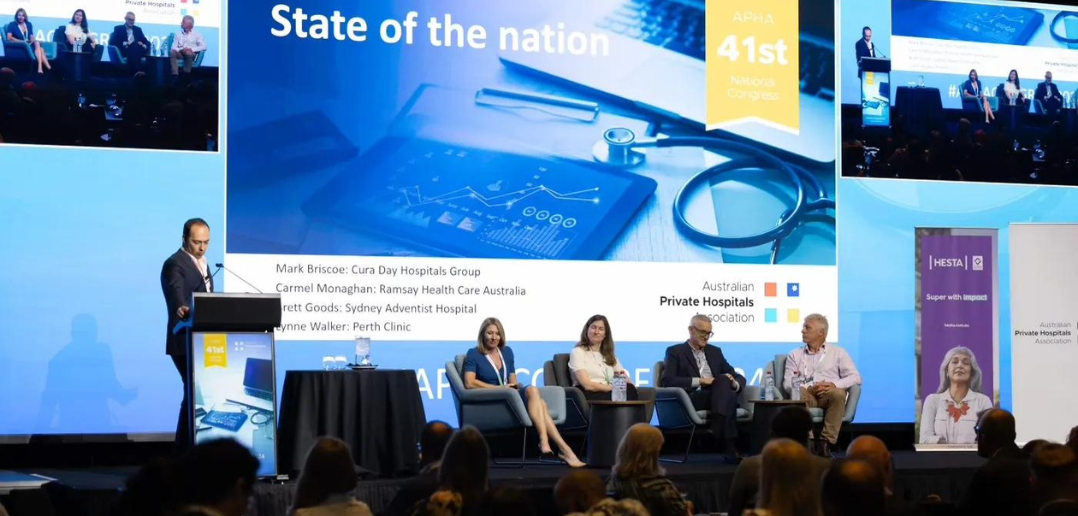Highs and lows of Australian healthcare

15/05/24
Australia’s healthcare system came under the microscope at the recent APHA 41st National Congress, with the ‘State of the Nation’ roundtable discussion tackling issues facing the sector.
The Australian Private Hospitals Association (APHA) interviewed a number of industry leaders to identify key factors asking: what is good about Australia’s healthcare system, what are the challenges it faces, and what needs to change?
The range of views were as diverse as the people interviewed – from Mark Butler, Minister for Health and Ageing to leaders in private health insurance, public hospitals, quality and safety, and also the media.
All agreed there was a lot to like about Australian healthcare, including universal access to care, Medicare, and the Pharmaceutical Benefits Scheme, resulting in a health system ranked highly in OECD comparisons.
However, the challenges remain. From significant gap fees and the viability of the private hospital sector, through to low bulk-billing rates and increasing demand for services, health leaders made their case.
Australian Medical Association President Steve Robson identified workforce issues as a major challenge.
“Our population is ageing. The illnesses that we have are becoming more complex and workforce is a massive problem in every sector across the health profession,” he said.
“Either we don’t have the health workforce we need, or it’s not distributed properly or available in the wrong places.”
The key themes were discussed by a panel representing a range of private hospitals.
Cura Day Hospitals COO Mark Briscoe, Ramsay Health Care Australia CEO Carmel Monaghan, Sydney Adventist Hospital CEO Brett Goods, and Perth Clinic CEO Lynne Walker shared their views on the highs and lows faced by the industry.
For Ms Monaghan, one of the biggest challenges was a lack of general practitioners (GPs).
“It’s a big problem for all of us, as GPs underpin our whole system,” she said.
“By 2030, we’re facing a 10,000-GP shortage, so that’s a big challenge as it means more people in hospitals.
“COVID really accelerated GP retirement, and there’s not enough people coming in and choosing to be GPs, they’re choosing other specialties.”
Mr Briscoe said the increasing costs of labour and regulation were a pain point for day hospitals.
“The paperwork and regulatory accreditation for a small day hospital is the same as a larger hospital,” he said.
“Also, the cost of digitisation and cyber security. It’s a huge ask for organisations to look after all that data and we must find a way to fund that moving forward.”
Despite the current challenges, all the panellists agreed the balance of the public and private systems was a win for Australia.
Ms Walker said Australians were lucky to have timely access to healthcare.
“I know it can be frustrating for people at times, but it’s a system worth preserving,” she said.
Ms Monaghan said the balance was important.
“We work globally, and we see it all the time,” she said.
“Plus, we have fantastic clinical outcomes here. Australia has the best five-year cancer survival rate in the world, and I don’t think we talk enough about how fantastic that is.”
Mr Goods said if the private system were to disappear, the cost to the Federal Government to replace it would be $6 billion.
The panellists also discussed the changes they would like to see in coming years.
“Trying to navigate the system, whether that’s public or private, is frustrating for people,” Mr Briscoe said.
“You’re giving the same information multiple times because your health information doesn’t travel well. Connectivity is a big challenge.”
Ms Walker said accessing mental health care was still a struggle for too many people, and Mr Goods said indexation reform was overdue.
“The private sector can play a greater role more broadly in the Australian healthcare system,” Ms Monaghan said.
“When we’re incentivised to innovate, we can do so quickly.”
